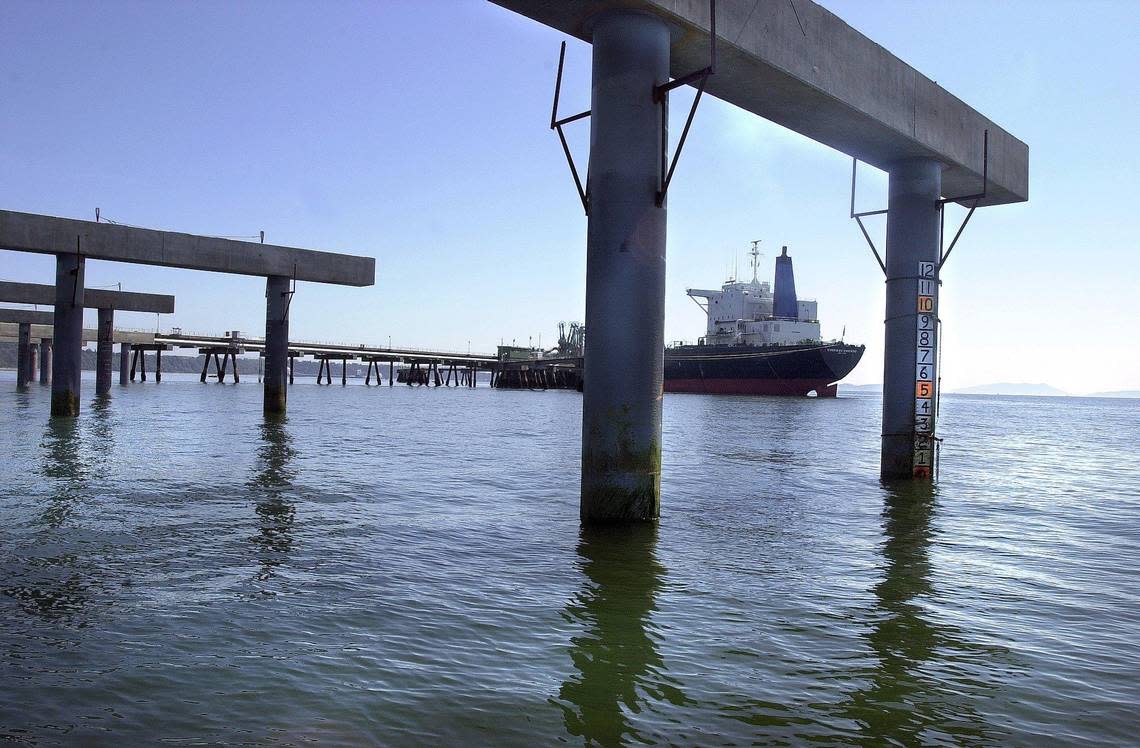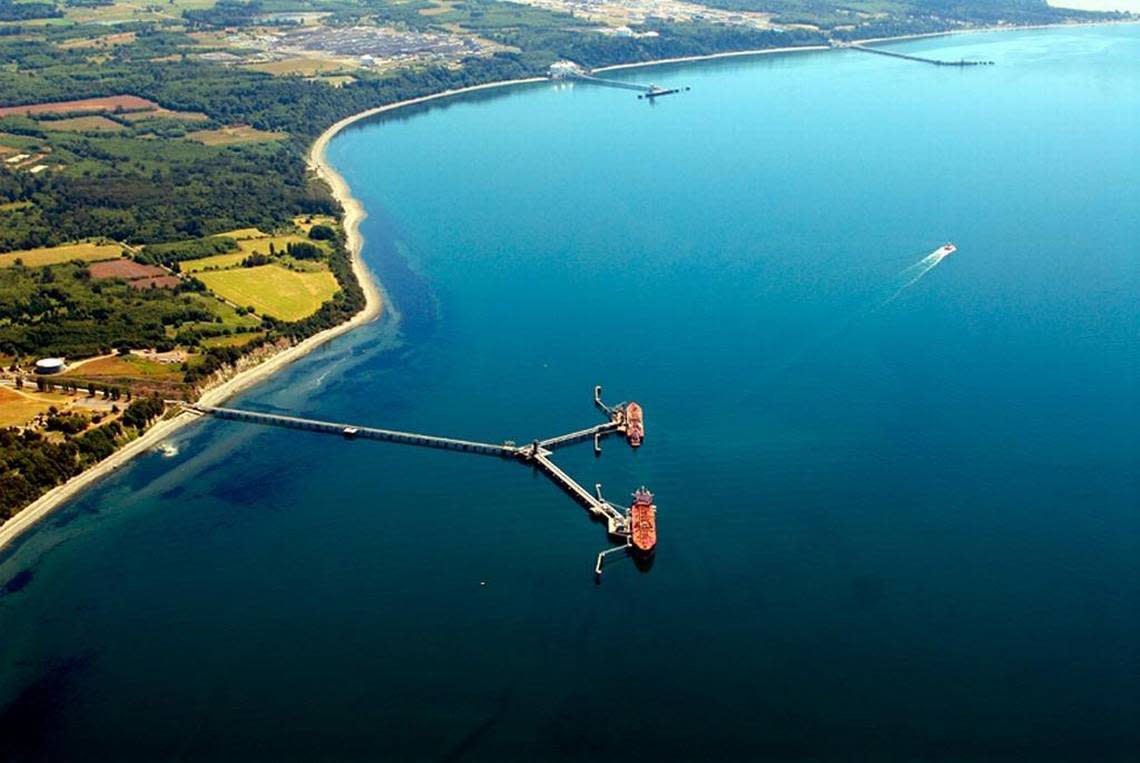These are the next steps in the contested permit for the north wing dock at BP Cherry Point
“The end of the story is still being written” about the contested permit for the north wing of the BP Cherry Point dock at the Whatcom County oil refinery, according to the U.S. Army Corps of Engineers.
The Corps’ final environmental impact statement was released this month, almost 20 years after environmental groups sued. The settlement also requires the Corps to file its record of decision by Nov. 10.
The report addresses the incremental environmental changes regarding the north wing of the dock. Analysis for the dock includes everything from oil spill possibility to impacted species and habitats.
The study, initiated by a lawsuit from environmental groups, will now go on to inform the U.S. Army Corps of Engineers and other decision-makers during discussions of the dock permit.
Following the Aug. 12 release of the final environmental impact report, a “cooling off” period takes effect for 30 days, according to Andrew Muñoz, chief of public affairs for the Seattle District of the U.S. Army Corps of Engineers, in a video interview with The Bellingham Herald. Sometime after the 30 days, a record of decision will be made by the Corps, deciding whether to uphold, alter or remove the permit it granted originally.
However, Daniel Krenz, environmental impact statement project manager, is unsure of the ability to make the timeline.
“That (timeline) may be difficult because of the ongoing discussion between the Corps, the Department of Justice and the third parties that are interested in this decision,” he said.
Included in the next phase of the process, before the decision, is a consultation with local tribes. Muñoz said part of the discussions include how operations will impact tribal treaty rights.
The Lummi Nation and Nooksack Tribe did not respond to requests for comment for this story.
Christina Audisho, BP media relations manager, said BP still was looking over the final environmental impact statement report two weeks after its release.
“(We) are prepared to work with the Army Corps of Engineers as they develop a record of decision on this matter, which will be issued later this year,” she said.
Public comments can be submitted to Daniel Krenz of the Corps.

Environmental study
The portion of the dock now called the south wing was built with the refinery in 1971 for ARCO. After a permit was issued by the U.S. Army Corps of Engineers in 1996, the north wing of the dock was added and completed in 2001, a year after BP purchased ARCO. Before the north wing was operational, several environmental groups sued the Corps claiming an environmental impact statement was needed.
The U.S. District Court, Western District of Washington, originally ruled in favor of the Corps. However, after the environmental groups suing as Ocean Advocates appealed the decision, the U.S. Court of Appeals for the Ninth Circuit ordered a full environmental impact statement from the U.S. Army Corps of Engineers.
The suit and appeal were based on a potential violation of the Magnuson Amendment, an extension to the federal Marine Mammal Protection Act. The amendment, originally enacted in 1977, limits the number of crude oil vessels in the waters of Puget Sound. This includes any permit by a federal government organization for a terminal, dock or facility that “will or may” increase the amount of crude oil a facility can manage. The baseline for oil volume is from Oct. 18, 1977, and does not include oil to be consumed in Washington state.
Cherry Point can process roughly 250,000 barrels of crude oil per day, according to the company’s website, and employs more than 890 people.

Increased vessel traffic
The final environmental impact statement has more than 700 pages of information gathered over the testing period. However, the document offers no conclusion from the information gathered, only data.
In a joint press release sent to The Herald via email on Aug. 19, the Friends of the San Juans, Friends of the Earth and Evergreen Islands offered their reactions to the report. The three groups were part of a lawsuit and settlement that compelled the Corps to release the report.
“While we appreciate the Corps upholding the terms of the settlement agreement to complete the FEIS, we’re dismayed by the Corp’s continued failure to account for and adequately mitigate the impacts of granting BP a permit that doubles its capacity to increase tanker traffic through our rich but vulnerable waterways,” Tom Glade, vice president of Evergreen Islands, said in the release.
The release said data from the final environmental impact statement report showed an increase in tankers and barges after the construction of the north wing dock.
These ships have docked at the BP Cherry Point refinery most frequently since May
“The potential impacts to our endangered orcas of a relatively small oil spill in the San Juan Islands caused by the sinking of a fishing vessel last week, underscores the necessity for the Corps to restrict the number of tankers allowed to call on the BP tanker terminal,” said Marcie Keever, oceans and vessels director for Friends of the Earth. “Such restrictions are the only way the Corps’ permit can comply with the Magnuson Amendment.”
While the immediate danger of increased crude oil refining and oil spills concerns one group, another raises concerns about an unknown future.
Simon Vickery, climate and energy policy manager at RE Sources, said they are worried for implications beyond the Puget Sound waters.
(The final environmental impact statement) is suggesting that more space to dock can potentially ease some bottlenecks for (the oil supply chain) and open up more oil production and more transportation,” he said.
